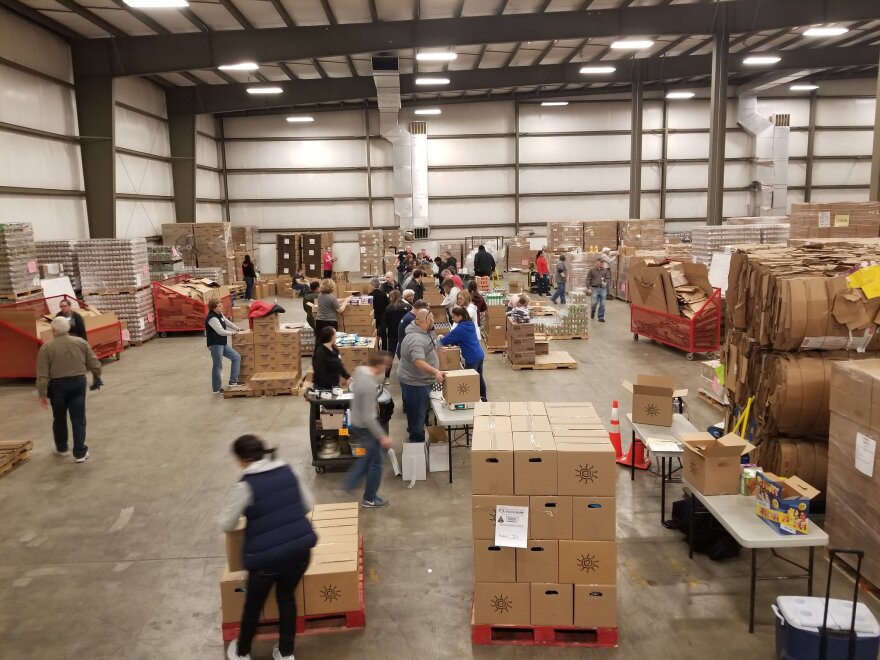ALLENTOWN, Pa. — Almost 100,000 people throughout the Lehigh Valley who rely on support from the Supplemental Nutrition Assistance Program had their benefits cut in March.
That, officials said, likely will force many to rely on local food banks to feed themselves and their families.
- Almost 60,000 people in Lehigh County received SNAP benefits in February 2023
- SNAP benefits will be cut $181 per month for the average household in Pennsylvania
- Food banks are preparing to help more families put meals on the table
The SNAP program, formerly known as food stamps, sends a monthly check to qualified low-income households to help pay for groceries. Since the start of the COVID-19 pandemic in March 2020, SNAP has provided more than 54,000 people in Lehigh County with a second emergency payment each month.
But those emergency payments have come to an end; federal lawmakers eliminated funding for them starting in March.
The average SNAP household in Pennsylvania will see its monthly benefits cut by $181, according to the state Department of Human Services.
State officials estimate a quarter-million households will see a further drop in their monthly SNAP benefits because of a cost-of-living increase for Social Security recipients, which could see up to 20,000 households in Pennsylvania removed from SNAP entirely.
Val Arkoosh, the department’s acting commissioner, said the monthly emergency payments have been a “lifeline” for families over the past three years and warned the reduction in benefits will primarily affect older residents and seniors in the state.
Safety nets cut down
With emergency payments ending at a time when inflation is driving the cost of food and other goods to new heights, food banks throughout the region expect to see a surge in clients.
The Allentown Area Ecumenical Food Bank provides groceries to about 7,000 people every month at its distribution center on 14th Street. But it’s preparing for that number to grow in coming weeks, Executive Director Anne Egan said.
“With the price of gas and the price of food, people have become accustomed to needing that money,” Egan said.
The food bank is working to ensure it has enough volunteers on hand, and it’s beefing up its partnerships with Second Harvest Food Bank and local supermarkets to bring in more food donations, Egan said.
The food bank is always seeking financial donations, she said.
“I'd say the real crisis for us at the food bank has really hit just within this last year, as some of those safety nets for people to avoid just this very situation during the pandemic have been taken away now."Allison Czapp, Second Harvest Food Bank director
At the start of the pandemic, lawmakers jumped into action — passing eviction moratoriums, boosting child tax credits, and approving stimulus checks, in addition to the SNAP emergency payments, Second Harvest Food Bank Director Allison Czapp said.
“All of these things were really working in tandem to prevent the real crisis,” Czapp said. “So now what we're seeing is, as those programs began to sunset, it was like each program ending caused a new wave of need in the Lehigh Valley [and] in our entire service area.”
'The real crisis for us'
Second Harvest is a regional organization that collects large food donations and distributes them to more than 200 food pantries, soup kitchens, senior centers and other groups in six counties: Lehigh, Northampton, Carbon, Monroe, Pike and Wayne.
It provides food for about 80,000 people in the Lehigh Valley and northeast Pennsylvania — about twice as many as it did before the start of the pandemic, Czapp said.
“I'd say the real crisis for us at the food bank has really hit just within this last year, as some of those safety nets for people to avoid just this very situation during the pandemic have been taken away now,” Czapp said.
Thousands of Lehigh Valley families relied on the emergency SNAP benefits to cope with an ongoing housing crisis and “historic inflation that has affected food costs kind of more than anything,” Czapp said.
“There was no phasing out, it was just, ‘You have the money. Now, you don't have the money.’"Second Harvest Food Bank Director Allison Czapp
Those payments “just stopped overnight,” she said. “There was no phasing out, it was just, ‘You have the money. Now, you don't have the money.’
"And it's difficult to understand how people are going to absorb that.”
SNAP enrollment in the Valley
Almost 2 million people, or about 1 in 7 Pennsylvanians, received SNAP benefits in February 2023, according to data provided by the state Department of Human Services.
That’s a 10.4% increase in enrollment since February 2020.
Lehigh County's SNAP enrollment figures have jumped 11.3% since the start of the pandemic, climbing from 53,692 people in February 2020 to 59,767 people in February 2023, DHS statistics show.
More than 34,000 people in Northampton County also received SNAP benefits in February 2023.
Total SNAP funding in Lehigh County doubled from March 2020 to April 2020 after the federal government approved monthly emergency payments.
Monthly SNAP funding in Lehigh County has fallen since hitting a peak of $23.5 million in May 2021 — when the federal government issued seven months' worth of back payments to recipients — but it remains about 150% higher than pre-pandemic totals.
SNAP recipients in the county received a total of $15.3 million in February 2023, according to DHS data. Statistics for March 2023 — the first month SNAP recipients won’t receive emergency payments — are not yet available.
Northampton County residents received just under $9 million in total SNAP benefits in February 2023, DHS statistics show.
Long-term solutions needed
Czapp said she hopes federal lawmakers make significant improvements to the SNAP program when they reauthorize the Farm Bill this year.
Pre-pandemic SNAP payments were “insultingly low” and “difficult for [families] to survive on,” she said.
“I don't think any food bank in America right now would tell you that the current situation that everybody is facing across America is sustainable in any stretch of the imagination,” Czapp said.
She urged lawmakers to study the “incredibly effective” programs launched during the pandemic and find long-term solutions to reduce hunger.
“This is something that could be solved through the legislative process,” Czapp said. “We need our lawmakers across America to know that this is important to everybody, not just those who are accessing the benefits right now.”
“People still need them because of the changes with inflation and the economy. They still needed benefits. People are hurting without them.”Allentown Area Ecumenical Food Bank Director Anne Egan
Allentown Area Ecumenical Food Bank Director Anne Egan called on state lawmakers to find funding for SNAP recipients affected by the cuts to the federal program.
The emergency SNAP payments are ending, but the need for help isn’t, she said.
“People still need them because of the changes with inflation and the economy,” Egan said. “They’re still needed benefits. People are hurting without them.”
Update your information
During his recent budget address, Pennsylvania Gov. Josh Shapiro urged state lawmakers to increase the minimum monthly SNAP benefit by 50% for seniors and people with disabilities.
More than 100,000 people in the state were receiving the minimum SNAP benefit in December, according to the governor’s office.
Shapiro’s budget proposal also provides funding for free breakfast for public school students across the state.
SNAP recipients should review and “update their information to ensure that they are getting the maximum amount of SNAP that they are eligible for,” state Department of Human Services spokesman Brandon Cwalina said.
Recipients can update their information at their local county assistance office or online through Compass, Cwalina said.


